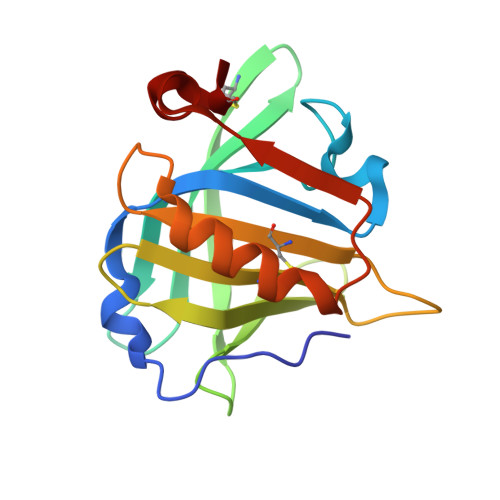Crystal structure of a secondary vitamin D3 binding site of milk beta-lactoglobulin.
Yang, M.C., Guan, H.H., Liu, M.Y., Lin, Y.H., Yang, J.M., Chen, W.L., Chen, C.J., Mao, S.J.(2008) Proteins 71: 1197-1210
- PubMed: 18004750
- DOI: https://doi.org/10.1002/prot.21811
- Primary Citation of Related Structures:
2GJ5 - PubMed Abstract:
Beta-lactoglobulin (beta-LG), one of the most investigated proteins, is a major bovine milk protein with a predominantly beta structure. The structural function of the only alpha-helix with three turns at the C-terminus is unknown. Vitamin D(3) binds to the central calyx formed by the beta-strands. Whether there are two vitamin D binding-sites in each beta-LG molecule has been a subject of controversy. Here, we report a second vitamin D(3) binding site identified by synchrotron X-ray diffraction (at 2.4 A resolution). In the central calyx binding mode, the aliphatic tail of vitamin D(3) clearly inserts into the binding cavity, where the 3-OH group of vitamin D(3) binds externally. The electron density map suggests that the 3-OH group interacts with the carbonyl of Lys-60 forming a hydrogen bond (2.97 A). The second binding site, however, is near the surface at the C-terminus (residues 136-149) containing part of an alpha-helix and a beta-strand I with 17.91 A in length, while the span of vitamin D(3) is about 12.51 A. A remarkable feature of the second exosite is that it combines an amphipathic alpha-helix providing nonpolar residues (Phe-136, Ala-139, and Leu-140) and a beta-strand providing a nonpolar (Ile-147) and a buried polar residue (Arg-148). They are linked by a hydrophobic loop (Ala-142, Leu-143, Pro-144, and Met-145). Thus, the binding pocket furnishes strong hydrophobic force to stabilize vitamin D(3) binding. This finding provides a new insight into the interaction between vitamin D(3) and beta-LG, in which the exosite may provide another route for the transport of vitamin D(3) in vitamin D(3) fortified dairy products. Atomic coordinates for the crystal structure of beta-LG-vitamin D(3) complex described in this work have been deposited in the PDB (access code 2GJ5).
Organizational Affiliation:
Department of Biological Science and Technology, College of Biological Science and Technology, National Chiao Tung University, Taiwan, Republic of China.

















